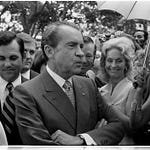
The ideal path to managing the challenges at the US border is proactively addressing the conditions leading to the influx of refugees.
What approaches could we use to address the underlying reasons for the refugee movement to the southern border?
Two Roosevelts left indelible marks on US policy in Central and South America.
In the 1904 Roosevelt Corollary to the Monroe Doctrine, President Theodore Roosevelt (R) outlined a new assertive interventionist policy towards Latin America. He called for the US to intervene with an international police presence to correct instability and chronic wrongdoing by our southern neighbors.
Roosevelt’s doctrine led to a series of military interventions and occupations collectively known as the Banana Wars. To protect US business interests and attempt to restore political and economic stability in the region, the US invaded Cuba in 1906, 1912, and 1917. We invaded Nicaragua in 1909 and 1912, Mexico in 1914 and 1916, Haiti in 1915, and the Dominican Republic in 1916. Many of these invasions became occupations into the 1930s.
The US fought several of these conflicts over US business interests and control of banana plantations. All told, the US occupied six southern neighbors over 30 years. Major General Smedley Butler, twice awarded the Medal of Honor for his actions in the Banana Wars, was the most highly decorated US Marine Corps officer of the time. Following his retirement, he described himself as a “racketeer, a gangster for capitalism.”
In December 1933, President Franklin D. Roosevelt (D) declared the US would no longer participate in armed intervention to attempt to govern other nations. FDR’s policy became known as the Good Neighbor Policy. The policy improved trade relations with Latin American countries and helped form an alliance among Western Hemisphere nations during World War II.
There’s no causal statement one could make that FDR’s policy improved the long-term stability of Latin American and South American nations. Attributing the long-term stability of an entire region to one policy is overly simplistic. However, we can conclude that the Teddy Roosevelt Corollary damaged relations and promoted instability. Its imperialistic and patronizing approach disrupted local governance, supported authoritarian regimes, and created uncertainty and conflict.
Fast forward to today.
The ideal path to improving the situation at the US border is not to try and do what we are already doing, just better. Even if we make staggering improvements and initially reduce undocumented movement across the border by half, but we don’t make long-term improvements, what would we have accomplished?
The ideal path to managing the challenges at the US border is proactively addressing the conditions leading to the influx of refugees.
Enhancing security measures at the US southern border doesn’t address the decisive issue: the continuous movement of refugees toward the border. No matter the effort we make to enhance security measures at the US southern border, if we don’t stop the flow of refugees to the border, we will continue to have security challenges.
What’s the best way to reduce this flow of refugees across the US southern border? We need to reduce the demand for refugees from Central and South America to flee their homes.
In sum, to address border security, we need to tackle the root causes prompting refugee migration in the Americas.
We need a comprehensive approach examining economic instability, violence, and political turmoil in the Americas. Latin America is diverse. A multi-dimensional approach is essential. This approach should comprehensively tackle economic, social, and security challenges while being tailored to each country’s unique needs and conditions.
As was the case during Teddy and Franklin D. Roosevelt’s time, we have various options.
We could do nothing and try to stop the flow of refugees across the border.
We could focus on border control without addressing the root causes of migration. While it might offer short-term success, more is needed to resolve the reasons refugees flee. Worse, this option may lead to a recurring or escalating crisis as the fundamental issues remain unaddressed.
We could intervene with force.
Military force can bring immediate but temporary solutions. This approach risks destabilization, potential backlash against perceived imperialism, and long-term consequences that may worsen the initial problems.
Neither of these options seems fruitful.
We could intervene with partnerships.
We could build cooperative relationships with regional countries to address the challenges jointly. The ultimate goal would be to achieve long-term solutions by addressing the root causes of instability and striving towards sustainable regional improvement. There’s a potential role for international and regional organizations, such as the United Nations, the Organization of American States, and other regional entities, to coordinate and support efforts to stabilize the region.
The most sustainable approach seems to be the third option - intervening with partnerships. To achieve progress, we must develop and implement solutions addressing economic challenges, reducing violence, and supporting political stability.
First, we need to address economic challenges in the region.
The United States implemented the Marshall Plan after World War II. The Marshall Plan is the shining example of an international policy that effectively addressed economic instability, violence, and political turmoil.
Following World War II, Europe was devastated. Our European partners faced economic ruin, political instability, and social upheaval. The risk of economic collapse and the potential spread of communism were significant concerns for the United States. Further, the US desired strong trade partners from allies it had in Europe.
At the beginning of the Marshall Plan, Will Clayton recognized the plan benefited America on the grounds of business interests. Newsweek described Clayton as “the principal architect of American post-war foreign economic policy.” Clayton founded the largest cotton brokerage firm in the world. Speaking of the Marshall Plan, he stated:
Let us admit right off that our objective has as its background the needs and interests of the people of the United States. We need markets--big markets--in which to buy and sell. - Will Clayton 1947 telegram to George C. Marshall
Democrats and Republicans alike have called for a Marshall Plan for Central America. Of course, post-WWII Europe and Central America are not the same. Many oppose a taxpayer-funded Marshall Plan applied to Central and South America because the conditions for the two regions are not similar enough to see dramatic benefits. They claim governance institutions in Central America are weak, and widespread violence further weakens the region’s stability.
Despite this opposition, efforts to address economic challenges in the region are already underway. Different presidential administrations take varied approaches. In an effort to reduce refugee migration, President Trump (R) froze $550M in taxpayer-funded aid for Central America that Congress authorized in 2017 and 2018, and an additional $450M in aid in 2019 when refugees kept moving to the southern US border. This year, Vice President Harris’ (D) Call to Action for Northern Central America announced she had organized $4.2B in private sector funding for Central America. The Harris-led initiative involves commitments from the private sector rather than direct funding from the US taxpayer. It’s an interesting model wherein investment from the private sector helps fund the achievement of public goals (such as addressing the root causes of migration).
Both approaches face significant challenges in leadership and the political landscape. In the short term, accountability with taxpayer dollars is appropriate. Any taxpayer-supported program must have robust monitoring and evaluation mechanisms to assess the effectiveness of interventions, allowing for improvements over time. Further, raising private investments to increase partner capacity also protects against the misuse of taxpayer funds. In the long term, systemic changes such as improving governance, education, and economic development may take a decade or more to develop.
Any funding approach needs to address fundamental economic push factors of migration, such as poverty and lack of employment opportunities. Tailored economic policies and initiatives should create jobs, promote entrepreneurial ventures, and stabilize local economies. We must implement educational programs and vocational training to equip individuals with the skills to succeed in their local economies. We must support initiatives promoting transparency, accountability, and protecting human rights.
Improving long-term economic conditions in Central and South America should reduce refugee migration as the countries have more economic resilience.
In addition to improving economic conditions in the long term, we need to help reduce violence in the region.
A component of reducing violence is building robust institutions. Federal, state, and local law enforcement efforts serve to protect Americans. Ioan Grillo, author of Blood Gun Money: How America Arms Gangs and Cartels, outlines a contrast between the US and Latin America:
But it is not those guns in civilian hands that make the difference between the United States and Latin America—it is institutions. Most Americans are not safe from a cartel storming their home to kidnap them because they have an AR-15. They are safe because the police and federal agencies have been hammering organized crime for decades. In Mexico, you see what a cartel hit squad looks like, and it is not something that you can stop on your own if they come for you, even if you have a bunch of guns.
In addition to providing support for Latin America for economic programs, we need to provide support and expertise for federal and local law enforcement programs to enable the people of Latin America to protect themselves.
Plan Colombia is a strong example of successful law enforcement and economic assistance. Significant funding for the Plan Colombia program started in 2000 with bipartisan support. The program focused on counternarcotics and counterterrorism. From 2000 to 2021, the US provided Colombia $12B in security and economic development aid, with very positive results. In 2015 alone, US exports to Colombia exceeded $15B. According to the US Global Leadership Coalition, homicides in Colombia were cut in half, while kidnappings and terrorist attacks declined by 90%. The US is now Colombia’s largest trade partner.
Rather than a Marshall Plan approach to Latin America, we need to consider a Plan Colombia approach that we can adapt to other countries while avoiding excessive militarization or human rights concerns. Further, this adapted Plan Colombia approach must include regional cooperation among Latin American countries, not just bilateral partnerships with the US. Initiatives that foster collaboration on cross-border issues can address trafficking, migration, and economic integration.
As a military force example, Representative Dan Crenshaw (R-Texas) advocates for US military force against the cartels. Crenshaw is himself a former Navy SEAL wounded in action during his third deployment to Afghanistan. Opponents state Crenshaw’s recommendations violate the sovereignty of, and threaten war with, our neighbors. In an interview with Grillo last week, Crenshaw identified that military intervention didn’t necessitate unilateral action by US forces and instead could include partnership and training with other national military forces. This option is tenable if partner nations reach out for training and assistance.
There’s another component of reducing violence in Latin America: US weapons.
Drug cartels pay Americans to smuggle weapons out of the US. Three relevant quotes from Grillo in Blood Gun Money:
Of the 16,343 firearms that Mexico submitted to the ATF [the US Bureau of Alcohol, Tobacco, Firearms, and Explosives] for tracing in 2018, 70.4 percent were definitively confirmed to have been made or sold in the United States.
Between 2014 and 2017, almost half, or 45 percent, of the firearms that Honduras submitted to the ATF for tracing were confirmed to be made or sold in the United States.
Honduras [is the] home of the biggest number of refugees arriving at the southern U.S. border.
US weapons destabilize and increase violence in Latin America. Violence in Latin America causes refugees to flee Latin America and move to the US. Therefore, US weapons leaving the US result in refugee movement across the southern border.
In addition to stopping the flow of refugees to the border, we need to take care of our own business and stop the flow of weapons headed south.
Economic development and security assistance work together. Economic development reduces the appeal of illegal activities. Security assistance protects economic gains. When combined with respecting the sovereignty and self-determination of our southern neighbors, both efforts support political stability, laying the groundwork for further partnership to build strong, resilient societies in Central and South America.
A region with economic opportunity and security will encourage refugees to stay rather than move to the US southern border.
What approaches could we use to address the underlying reasons for the refugee movement to the southern border?
No matter the effort we make to enhance security measures at the US southern border, if we don’t stop the flow of refugees to the border, we will continue to have security challenges.
We must intervene with partnerships, building cooperative relationships with regional countries to address challenges jointly. We must develop and implement solutions that address economic challenges, reduce violence, and support political stability to achieve progress. Challenges in the region are deep-rooted and complex and require a long-term commitment from the US and its partners. Short-term measures are insufficient to create lasting change.
Focusing on economic development and security assistance will reduce the appeal of illegal activities and protect economic gains. When combined with respecting the sovereignty and self-determination of our southern neighbors, both efforts support political stability, laying the groundwork for further partnership to build strong, resilient societies in Central and South America.
A region with economic opportunity and security will encourage refugees to stay rather than move to the US southern border.
May God bless the United States of America.














Share this post